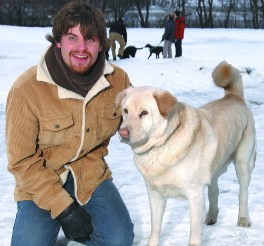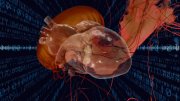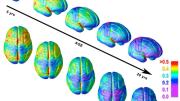A chimpanzee enters a room where food is hidden in one of two opaque containers. A human gazes at the container that hides the food. Reaches for it with outstretched arm. Marks the container with a wooden block. The chimp doesn’t get the message, even though chimpanzees are one of Homo sapiens’ two closest extant primate relatives and might be expected to figure it out. Biological anthropologist Brian Hare and colleagues tried this game with 11 chimps, and only two of the brainy apes used the conspicuous cues to find the food.
 |
Anthropologist Brian Hare, whose field is the evolution of human cognition, with consultant Milo |
Photograph by Stu Rosner |
Dog owners may not be surprised to learn that nine of 11 dogs in the same situation correctly read the human signals and found the food. A control exercise established that odor was not a cue in either trial.
A wolf raised by humans enters the room. The experimenter gazes at the baited container. Points at it. Even taps it. The wolf doesn’t perform above chance on any of these cues. Seven dogs and seven wolves take a turn. The dogs find more food than the wolves in response to each of the three visual cues, even though wolves are dogs’ closest relatives. Recent research by Peter Savolainen and colleagues at the Royal Institute of Technology in Stockholm convinces them that all dogs, from the Mexican hairless to the komondor, from the Scottish terrier to the borzoi, descended from a very small number of East Asian wolves who lived roughly 15,000 years ago.
A puppy dog enters the room. It, too, finds food better than chimps and wolves. Hare, a fifth-year graduate student at Harvard whose work was largely funded by the Max Planck Institute in Germany, gazed, and then gazed and pointed, with 32 puppies, varying in age from nine to 26 weeks, including puppies who had had little contact with humans. The ability of a dog to perceive the meaning of his gestures is innate, he concludes, not learned over the course of a dog’s life.
Email Address
Bottom of Form
Reporting their findings in Science magazine last fall, Hare and his team concluded, “These findings suggest that during the process of domestication, dogs have been selected for a set of social-cognitive abilities that enable them to communicate with humans in unique ways.” Of the wolves who hung around a campsite hoping to snare food from the scrap heap, perhaps the one most adept at fathoming human gestures was the one most likely to prosper. Perhaps an early wolf-dog helped a human to hunt and earned a place by the fire that way.
Hare believes that the dog gained an evolutionary edge by learning to understand human cues, that humans selected for breeding the dogs that had this skill. But possibly Fido’s canniness is simply a byproduct of domestication, not a deliberate human goal.
Hare hopes to explore the byproduct hypothesis in Siberia this summer. A research group at the Institute of Cytology and Genetics in Novosibirsk, building on work of the late geneticist Dmitry K. Belyaev, has bred silver foxes for 45 years, selecting not for trainability but for tameness. “When the kits were four weeks old,” says Hare, “a researcher would stand in front of their cage. The kits who came forward were saved and eventually allowed to breed, the ones who moved away were culled.” The foxes have indeed become tame—enough to be house pets. (They changed in other ways, too, as dogs did in their domestication. Their fur changed color, their brains grew smaller, they became more gracile, and their ears got floppy. Darwin observed that “not a single domestic animal can be named which has not in some country drooping ears,” a feature not found in any wild animal except the elephant, the institute’s Lyudmila Trut has noted.)
Have the Belyaev silver foxes acquired a doglike ability to read human cues? If so, the byproduct hypothesis will be strengthened, because they were not selected for trainability. Hare wants to try the baited-container game on these unique foxes, which have become calmer in domestication than their wild ancestors, he says, just as dogs did. Perhaps that will help them discern the meaning of his gazing and pointing and tapping. The foxes may be better at finding the hidden food than chimps and wolves, but will they do as well as man’s best friend? Hare has his money on the dogs.








